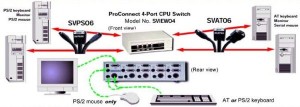Blast from the past: originally published October 20th 2000.
Let’s jump right in this week and take a look at the Linksys ProConnect CPU Switch. I bought the four CPU model SVIEW04 to clear some desk space; two monitors, keyboards and mice plus the hassles of switching them when I added in a third PC. My home network employs a server and three clients, plus any machine I’m fixing or working on. This made for too much real estate in my tiny office, so a KVM ( keyboard, video, mouse ) switch looked like the way to go.
I had specific requirements to meet, as I needed both PS/2, DIN and serial connections. All machines from the last three years use PS/2 connections, but I have a Pentium Pro machine that uses the DIN keyboard connector and a serial mouse, plus you never know what someone will bring you to look at.
After searching online, I found KVM switches fell into two categories; 2 and 4 port PS/2 models for around $100 or 4 and higher port models for $300 plus that supported all connections. As well most of these didn’t include the cables needed to connect the switch to the PC, with an added cost of $30 per cable kit. For SOHO environments the PS/2 models would fit the bill nicely, as long as you don’t need legacy support for older systems.
A little more legwork brought me to the Pro four port versions of Linksys and Belkin; both in the $200 range with $25 cable kits. Linksys has served me well to this point with their network equipment, so I picked up the SVIEW04 ProConnect model and three cable kits. The irony here is that I’m still waiting after six weeks to get a serial cable kit, so I was only able to test the PS/2 connections.
The SVIEW04 is a small box the size of a hardback book with a power button and four switches on the front to change the active computer. Above each switch are two lights; a green light to indicate the active connection and a red light to indicate power. On the back are the input ports for the monitor, keyboard and mouse you’ll use for control and the four sets on output connections. Check out a nice diagram of the setup from the Linksys site. Turn off all your systems, plug in the cables, turn on the KVM switch and power on the PCs.
Once everything was up and running I turned on my server and a client PC and flipped back and forth between them without difficulty. The switch worked as advertised, cleanly and quickly. One quirk was that after I powered down the client PC the red power light stayed lit on the switch; I’m guessing this is because of the ATX power supply that doesn’t really turn itself off.
I next added an older IBM Pentium 133 desktop; plugged in the cables and started it up. Everything worked fine so I shut it down and switched the KVM to my server. A while later I powered the IBM back up without switching to it and heard a warning beep from the machine; it couldn’t detect a mouse. Turn the IBM off, switch the KVM to it, power the IBM back on and no problems. This could be a quirk of the switch, the Microsoft Intellimouse or the IBM PC; either way I see it as a slight negative but not an issue.
After working with it for two weeks I’m finding a KVM switch invaluable. With the switch and four cable kits the bill was a little over CDN $300, but compare that to the money you’ll save from not buying more monitors, keyboards and mice.
February 10th 2003
It’s been almost three years of continuous use with the SVIEW04 and I’ve only found one problem. My server is on the first position and is powered on 24/7. A spare PC is on the second, and the other spots are free for testing and repairs. When playing a game with intense mouse activity, and what game doesn’t, after a while the mouse stops working. At first I thought this was related to using a mix of PS/2 and AT style connectors, but disconnecting the last two positions didn’t fix this. Based on this I can’t recommend this KVM for game players, but otherwise it’s worked well.

